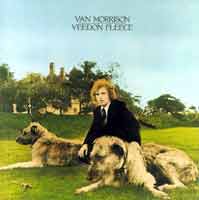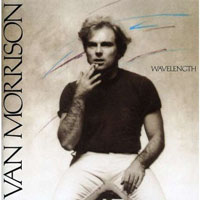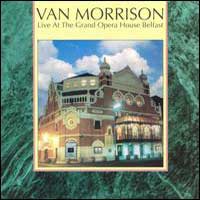|
"The best-produced, most ambitious Van Morrison record
yet released, Saint Dominic's Preview presents an impressive assemblage
of musical ideas that can be enjoyed on many levels. Though the album
does not have quite the surface accessibility of Tupelo
Honey, being melodically less predictable and lyrically more esoteric,
its overall content is musically much richer and more adventurous.
Five of the album's seven cuts pick up where Tupelo
Honey left off, as Van and many of the same crew who put together
Tupelo further refine and extend the possibilities of the mainstream road-house
band sound that has characterized Van's last three albums. In contrast,
the two longest cuts, "Listen to the Lion" and "Almost
Independence Day," run 10 and 11 minutes respectively, and mark a
welcome return to the meditative vitality of Astral Weeks. The coexistence
of two styles on the same record turns out to be very refreshing; they
complement each other by underscoring the remarkable versatility of Van's
musical imagination.
As in Tupelo Honey,
the mood here is one of celebration and expectation, but this time not
in terms of a relationship within a particular setting. Above all, Saint
Dominic's Preview invokes the possibility of profound self-revelation
through being on the road and making music. Often there is a feeling of
thrilling mystical presentiment. All this is expressed in such a dazzling
variety of ways that at first listening Saint Dominic seems to be a less
unified work than Tupelo or Astral
Weeks. The point, however, is that Van is deliberately proclaiming
his freedom from musical style or place (either the specific southern
locale of Tupelo or the mythic arena of Astral
Weeks.) Images of travel abound, adding up to a summons to high adventure-actual,
imaginative, and musical.
The album opens with "Jackie Wilson Said (I'm in Heaven When You
Smile)," a neat three-minute salute to soul then moves into "Gypsy,"
in which Van states where he's at artistically; the rhythms, alternating
between double and triple time, are driving and excited, the harmonies
faintly Middle Eastern, and the multiple guitar textures exotic. The song
demonstrates that Van is precisely a musical gypsy-cryptic, sensual, and
shrewd-a master at casting spells and at leading us through whatever territory
he feels like exploring. While both cuts show off the band in its funky
style, the third cut, "I Will Be There," goes the furthest of
any into R&B-jazz roots, as Van pays expert musical tribute to Count
Basie and Joe Williams.
The excellence of these cuts isn't based on any major innovation, but
on the homogenization of diverse but familiar ideas under the auspices
of a single strong personality. But just as impressive as Van's personal
stamp is the band's marvelous ensemble virtuosity. At the forefront of
this evolving "roadhouse" sound are two saxophones (alternately
played by Jack Schroer, Boots Houston, and Jules Broussard). The greater
prominence of saxophone, plus the development of a more integrated and
generally denser "band" sound in which Van's singing is somewhat
laid back, mark the chief departures on these cuts from the sound of Tupelo.
Saint Dominic's Preview gets better as it goes along. The extended meditation,
"Listen to the Lion," which closes side one, is magnificent.
Here, as on much of Astral
Weeks, the momentum is carried forward by incantatory rhythmic strumming
(Van and Ronnie Montrose). But whereas the music on Astral Weeks was augmented
by strings, "Listen to the Lion" uses subdued backup vocals
(Montrose, Houston, and Van) to achieve the same hypnotic effect. The
result is a purer but no less captivating sound than on Astral Weeks.
Musically and lyrically, the cut builds slowly to an intense climax through
the use of repeated short musical and lyrical phrases that gradually metamorphose
without totally changing shape, and then subside, gradually surrendering
tension like the release of a deep breath. Van begins: "Listen to
the lion inside me." As the idea is developed it becomes, "and
all my tears like water flow for the lion inside me," and ends, "and
we sailed looking for a brand new start." As the song reaches peak
intensity Van's singing becomes more and more gutteral until it is almost
a feral muttering.
The six-and-a-half-minute title cut which opens side two nicely straddles
the gap between the album's two styles. Instrumentally it is very similar
to "Tupelo Honey."
The arrangement and vocals are joyously full-bodied and enhanced by John
McFee's steel guitar. However, the dense verbiage (more complex than on
any other cut) is disjunctive and arcane, juxtaposing images of mythic
travel, with those of social alienation, with reference to James Joyce
and Northern Ireland. Within this deliberately obscure but provocative
narrative recurs the refrain of Van's apocalyptic vision which he calls
Saint Dominic's Preview. I was uneasy about Van's insistence on employing
a basically private mythology in Astral Weeks, evocative as it was, and
I am uneasy about "Saint Dominic's Preview" for the same reason.
The words are difficult to follow, and the album provides no lyric sheet.
Nevertheless Van achieves his effect-contrasting a restless, ominous perspective
of the present with his certainty of a positive, perhaps ultimate resolution
just ahead. The affirmation of "Saint Dominic's Preview" is
translated to the past in "Redwood Tree," an ecstatic boyhood
reminiscence centering on the image of a sheltering redwood tree. This
beautiful, sensuous cut has the album's greatest potential as a hit single.
"Almost Independence Day," the ten-minute concluding cut, is
a moving summation of what has preceded. Structurally akin to "Listen
to the Lion," it duets Van and Ron Elliott on 12-string and 6-string
guitar and effectively uses the Moog as a sort of foghorn bass. Grandly
opening with references to the Stones' "Moonlight Mile," the
body of the song is an incantatory montage of simple, portentous phrases
repeated over and over with varying emotional emphasis: "I can hear
the fireworks echoing up and down San Francisco Bay. I can see the boats
in the harbor, lights shining out in a cool cool night. I can hear the
fireworks. I can hear the people shouting out, up and down the line. And
it's almost Independence Day, way up and down the line." As in "Listen
to the Lion," the structure of the song is metamorphic, taking the
form of a rising and subsiding wave. Music like this is so personal and
private that you either relate to it or you don't. It can be faulted on
so many grounds- formlessness, self-indulgence, monotony-by those who
are unwilling to listen long and hard. For me, the deeply compelling quality
of Van Morrison's trips is embodied in their very evanescence-in the fact
that the forces he conjures are beyond precise articulation and can only
be suggested. (STEPHEN HOLDEN, US-Rolling Stone)
|

 Inselplatte #11 in Jahresliste
Inselplatte #11 in Jahresliste  Plattentipp
Plattentipp 







































 #71 Virgin/Colin Larkin(2000)
#71 Virgin/Colin Larkin(2000)

 #48 Rock Critics Choice(1978)
#48 Rock Critics Choice(1978) 